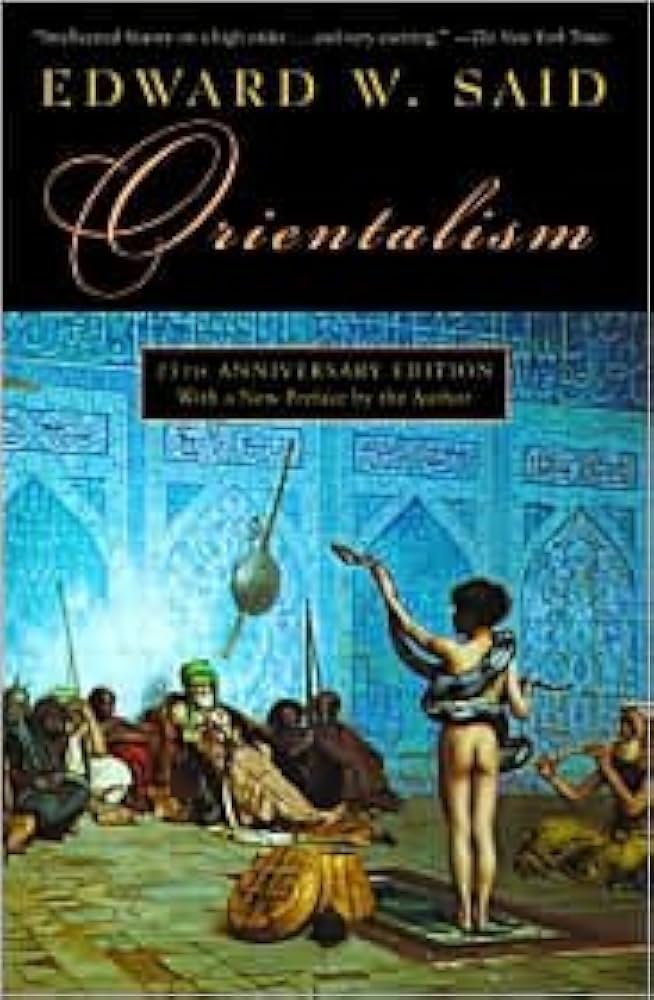In a world increasingly defined by the complexities of cultural interactions and the legacies of colonialism, Edward W. Said’s groundbreaking work, “Orientalism,” emerges as a critical beacon illuminating the intricacies of East-West relations.”‘” invites readers to delve into the profound implications of Said’s analysis, challenging entrenched perceptions and urging a reconsideration of historical narratives. Through a meticulous examination of Said’s arguments, this review seeks to unravel the layers of his critique, exploring how his insights have shaped contemporary discourse on identity, representation, and power dynamics. As we navigate the intersections of knowledge and ideology, we discover that “Orientalism” is not merely a response to specific historical events, but a living dialog that continues to resonate in today’s global landscape.
Exploring the Cultural Landscape as Seen Through Edward W. Said’s lens

Through the lens of Edward W. Said, the cultural landscape of the East is not merely a collection of exotic symbols but a complex web of identities shaped by historical interactions and power dynamics.His critique of Western representations—termed “Orientalism”—reveals how literature, art, and academic discourse have long contributed to a skewed perception of Eastern societies. This construction of the “Orient” serves to define the “Occident,” positioning the West as rational, progressive, and superior while relegating the East to a realm of mystique and barbarism. The significance lies in how these narratives have influenced geopolitical relations and continue to shape cultural exchanges today, prompting us to critically assess the narratives we consume and propagate.
to understand the implications of Said’s analysis, one must consider the multifaceted ways in which cultural representations manifest.These can be categorized into diffrent spheres, each revealing the intricate connections between power and representation:
- Literary Imagery: Works of fiction often depict the east as a backdrop for Western adventure and moral dilemmas, reinforcing stereotypes.
- Artistic Expressions: Visual arts from the colonial era often reduced Eastern subjects to mere objects of fascination, stripping them of agency.
- Academic Discourse: Scholarship has historically marginalized Eastern voices, framing them through a western-centric lens that fails to capture their complexity.
Through examining these elements, it becomes evident that Said’s critical gaze invites readers to question not only historical narratives but the ongoing cultural dialogues that continue to define our understanding of “the other.” This exploration prompts a rethink of how cultural narratives are constructed and the ethics surrounding representation in contemporary society.
The Foundations of orientalism: Dissecting Historical Context and Implications

At the heart of Edward W. Said’s critique lies the notion that Orientalism is not merely a study of the East but a complex discourse deeply intertwined with the political and cultural power dynamics of the West. This framework examines how Western portrayals of Eastern societies have historically been constructed, maintained, and utilized to justify colonial and imperial ambitions. By framing the Orient as a place of exoticism and backwardness, these depictions served to establish a dichotomy between the ‘civilized’ West and the ‘primitive’ East. this cultural narrative has resulted in a range of implications that not only shaped academic scholarship but also influenced popular perceptions of Eastern cultures through various mediums. The legacy of these representations has perpetuated stereotypes, oversimplifications, and a general misunderstanding of diverse Eastern societies.
Furthermore, the historical context surrounding Orientalism reveals a significant interplay of power and perception. The rise of colonial enterprises in the 19th century led to the institutionalization of knowledge about the East, frequently enough characterized by selective representation and ideological manipulation. Key points to understand this phenomenon include:
- Colonial exploitation: Knowledge was a tool for governance, legitimizing control over colonized territories.
- Cultural hegemony: Western scholars often portrayed themselves as arbiters of knowledge, sidelining indigenous narratives.
- Economic motivations: The allure of the Orient fueled trade interests and cultural appropriation.
This tableau of interactions not only reflects the historical implications of Orientalism but also underscores its persistent relevance in contemporary discourse. The framing of Eastern societies,as crafted through a Eurocentric lens,has lasting effects on international relations,cultural exchange,and even policy-making,making it imperative for us to continually interrogate and challenge these narratives.
Unpacking Stereotypes: The Dichotomy of East Versus West in said’s Work

In Edward W.Said’s seminal work, the concept of the East versus West presents a complex web of cultural and historical stereotypes that resonate through literature, art, and politics. By examining the dichotomy established by colonial narratives, Said illustrates how the West has constructed the Orient as an exotic, inferior counterpart to its own identity. This representation fosters a sense of Western superiority while together creating a distorted image of Eastern cultures, which are often relegated to a status of the “other.” The implications of this stereotyping are profound, as they not only affect international relations but also influence personal perceptions, shaping social dynamics on both sides.
Central to this discussion is the portrayal of key stereotypes that emerge within Said’s framework, including notions of mystique, barbarism, and passivity attributed to Eastern societies. These stereotypes provide a convenient lens through which Western scholars and artists have historically viewed the east, but also reveal the underlying power structures at play. To better understand these cultural constructs, we can examine their characteristics in a comparative format:
| Western Stereotype | Eastern Counterpart |
|---|---|
| Rationality | Irrationality |
| Progressive | Backwards |
| Individualism | Collectivism |
This stark contrast illustrates how cultural representations can lead to sweeping generalizations while perpetuating a narrative that simplifies the complexities of diverse societies. Acknowledging these stereotypes is essential for dismantling the inaccurate portrayals that persist today, and encourages a deeper examination of our own preconceptions about different cultures.
The Impact of Artistic Representation on Orientalisms Perception and misconception

Artistic representations have long shaped the Western understanding of the East, often fostering a skewed perception of diverse cultures. Through exotic imagery, literature, and performance, artists have contributed to a dominant narrative that casts the East as a place of mystery and sensuality, ultimately aligning with colonial ideologies. This is evidenced by various forms of art that portray the East as:
- A playground for Western fantasies, where the allure of the “other” is romanticized.
- A stagnant backdrop, reinforcing stereotypes of passivity and timelessness.
- A source of inspiration for western artists, who often appropriated Eastern motifs without context or understanding.
This artistic framing has consequences, not just for the portrayal of Eastern cultures but also for the psyche of those belonging to these societies. as these images become ingrained in popular consciousness, they can lead to a pervasive sense of misrepresentation. To elucidate this phenomenon, consider the following comparison of artistic perceptions against the realities of Eastern cultures:
| Artistic Perception | Reality |
|---|---|
| Exotic & Mysterious | Diverse & Complex |
| Timeless & static | Evolving & Dynamic |
| Esoteric & Spiritual | Secular & Varied |
These discrepancies not only highlight the limitations of artistic representations but also emphasize the necessity for critical engagement with such portrayals. By unraveling these layers, we can move towards a more nuanced understanding that honors the multifaceted realities of Eastern cultures, while also challenging the long-standing orientalist paradigms that continue to influence perceptions today.
Revisiting Colonial Narratives: said’s Influence on Postcolonial Thought

Edward W. Said’s groundbreaking work, Orientalism, serves as a crucial lens through which the colonial narratives of the East and West can be re-evaluated. His conception of the “Orient” as a fabricated construct,rather than a mere geographical designation,challenged the customary narratives that frequently enough glorified imperialism while demonizing the colonized. This pivotal shift invites scholars to consider the implications of representation in literature and art, emphasizing that knowledge is inherently linked to power.Key elements that emerge from Said’s analyses include:
- Binary Oppositions: The West vs. the East as a fabricated contrast.
- Cultural Hegemony: How dominant cultures assert influence over marginalized ones.
- Identity Construction: The role of the ‘Other’ in forming Western identity.
As postcolonial thought evolved, Said’s influence prompted scholars to interrogate the intricacies of colonialism and resist simplistic dichotomies. His work emphasizes that colonial discourse is not merely an act of domination; it is indeed also a dialogue that reflects the contested nature of identity. The impact of this perspective can be summarized in the following table:
| concept | Description |
|---|---|
| Self and other | Explores relationship dynamics defining identities. |
| Resisting Narratives | Encouraging marginalized voices to redefine their stories. |
| Hybridity | Understanding mixed cultural identities as a product of colonial encounters. |
By diving into these concepts, one can see how Orientalism acts as a foundational text that not only critiques colonial endeavors but also opens up avenues for further discourse. The critical examination of these colonial narratives signifies that understanding our past is paramount in deconstructing current cultural paradigms,ultimately paving the way for a more nuanced global conversation.
Intersection of Power and Knowledge: Analyzing Said’s Theoretical Framework

Edward W. Said’s exploration of the relationship between power and knowledge redefines our understanding of cultural representations and their implications. At the core of his argument is the idea that knowledge is not merely a reflection of reality but a tool used by the powerful to shape perceptions and sustain dominance. This is evident in how Western narratives about the East create a binary that not only marginalizes but also dehumanizes, constructing the ‘Orient’ as an exotic ‘Other.’ Through this lens, knowledge becomes a mechanism of control, where academic, artistic, and literary depictions serve to reinforce colonial ideologies and justify imperial ambitions.
The implications of Said’s framework extend beyond literary critique, challenging readers to reconsider the entanglements of representation and authority. In examining various texts, it becomes clear that the dynamics of hegemony are intricately linked to the production of knowledge, blurring the lines between the observer and the observed. Key elements of this discourse include:
- Discourse Formation: The ways in which narratives are constructed within existing power relations.
- Othering: The process of defining oneself in contrast to an ‘Other,’ often leading to stereotypes and oversimplifications.
- Resistance and Agency: The potential for subaltern voices to challenge dominant narratives and reclaim their identities.
This framework invites a critical reflection of contemporary global interactions, where echoes of Orientalism persist in media and politics. To illustrate the ongoing relevance of Said’s insights, the following table summarizes the dichotomy between Western and Eastern representations:
| Western Perspective | Eastern Representation |
|---|---|
| Exotic and Backward | Culturally Rich and Diverse |
| Monolithic Stereotypes | Pluralistic Realities |
| Victim of Circumstances | Agent of change |
Critical Reception: How Scholars Have Responded to Orientalism Over Time

The reception of Edward W. Said’s *Orientalism* has generated a rich tapestry of scholarly discourse spanning decades. initially met with both acclaim and criticism, the book’s argument that Western depictions of the East serve to justify colonialist attitudes led to significant debates among historians, literary critics, and cultural theorists. Some scholars praised *Orientalism* for its groundbreaking analysis, highlighting its impact on post-colonial studies and the fields of literature and cultural criticism. The work encouraged a generation of authors and critics to reevaluate how Eastern societies are portrayed in Western art and literature, directing attention to the consequences of these representations.
Conversely, critiques emerged regarding the book’s perceived oversimplifications and essentialist views of Eastern cultures.Detractors like Aijaz Ahmad contended that Said’s framework sometimes neglects the complexities and diversities of the societies he examined. Scholars have also argued for a more nuanced understanding of the exchange between East and West, emphasizing the interplay of power dynamics rather than a one-dimensional narrative of a victimized “Other.” In this light, contemporary discussions around *Orientalism* have expanded to explore choice methodologies and perspectives, paving the way for new interpretations that integrate post-colonial theories with feminist and queer studies. The dialogue continues to evolve, reflecting the dynamic nature of cultural criticism.
Contemporary Relevance: applying Said’s Insights to Modern Global Dynamics

In today’s interconnected world, Edward W. Said’s critique of Orientalism provides a vital lens through which to examine ongoing global dynamics. With the rise of populism and neo-nationalistic movements across various nations, the implications of Said’s work resonate in how cultures interact and are perceived. His concept of the West’s construction of the East as the ‘Other’ highlights a persistent pattern of stereotyping and simplification, calling attention to contemporary media’s role in perpetuating these narratives. in a digital age where facts is instantaneous and pervasive, the portrayal of different cultures can swiftly shape public opinion, reinforcing outdated images and biases.
Moreover, as global conflicts continue to arise, understanding Said’s insights into cultural representation remains crucial for fostering dialogue and resolving misunderstandings. The following points underscore the relevance of his theories in modern contexts:
- Cultural Misrepresentation: Media portrayals often reduce complex societies to oversimplified stereotypes.
- Global Power Dynamics: Disparities in cultural narratives can impact international relations and policy-making.
- Identity and agency: Recognizing authentic voices within communities challenges dominant narratives and promotes self-representation.
By critically engaging with Said’s ideas, scholars, policymakers, and citizens alike can better navigate the challenges of cultural misunderstanding, working towards a more inclusive global dialogue.
A Journey Through Literary Critique: Understanding the Narrative Techniques of Said

Edward W. Said’s exploration of narrative techniques extends beyond mere storytelling; it serves as a lens through which we can deconstruct Western perceptions of the East. Said’s prose intricately weaves autobiographical elements with critical theory, creating a rich tapestry that invites readers to question the dichotomy of ‘us’ versus ‘them.’ This reflexivity in his writing style challenges conventional boundaries, encouraging a deeper understanding of how cultural narratives shape both identity and power dynamics. By dissecting the language of representation,he unveils the hidden biases and assumptions that underpin scholarly discourse,ultimately suggesting that the narratives we consume govern the realities we construct.
In his seminal work,Said employs various narrative techniques that are pivotal to his critique of colonial discourse. These include intertextuality, juxtaposition, and irony, each contributing to a multi-layered reading experience that forces readers to grapple with uncomfortable truths.For instance, his use of juxtaposition between Western texts and Eastern realities highlights the disparities that inform cultural stereotypes, prompting an examination of the implications of such representations. The following table summarizes notable narrative techniques employed by Said, illustrating their impact on the reader’s understanding:
| Technique | Description | Impact |
|---|---|---|
| Intertextuality | References to other texts to enrich meanings | Encourages critical engagement with sources |
| juxtaposition | Contrasting Western and Eastern narratives | Reveals ideologies behind cultural constructs |
| Irony | Use of humor to expose contradictions | Provokes reflection on perceived truths |
comparative Analysis: Orientalism in Context with Other Cultural Theories

When examining Edward W. Said’s Orientalism, it becomes essential to contextualize it within the broader landscape of cultural theories that address power dynamics and representation. One impactful framework to consider is Postcolonialism, a theoretical approach that critiques the continuing legacy of colonial power structures and cultural impositions. while Said’s work focuses primarily on the East-West dichotomy,postcolonial scholars expand this dialogue by exploring how colonized nations negotiate identity and agency in the wake of colonial oppression. this interplay can be seen in the following aspects:
- Representation: Both frameworks underscore the significance of how cultures are perceived and portrayed.
- Power Dynamics: The critique of Western dominance and the efforts to reclaim narratives from the margins.
- Identity: An emphasis on the complex nature of identity formation in the postcolonial era.
Another relevant theory is Cultural Studies, which analyzes the impact of culture on societal structures and vice versa. Through a lens informed by cultural studies, Orientalism can be deconstructed further by considering how media, literature, and visual arts contribute to the construction of the “Other.” In this context,the following elements emerge:
| Aspect | Orientalism | Cultural Studies |
|---|---|---|
| Focus | West’s view of the East | Intersection of culture and society |
| Methodology | Critique of representation | Interdisciplinary analysis |
| Impact | Solidification of stereotypes | Change of cultural discourses |
Challenging Assumptions: What Readers Might Misinterpret from Said’s Work

Edward W.Said’s Orientalism has often been misinterpreted, leading to a series of misunderstandings regarding its core arguments and implications. Many readers, upon first encountering Said’s text, might hastily conclude that he condemns all Western scholarship on the East or reduces complex cultures into simplistic binaries. This interpretation overlooks the nuanced critique that Said presents, which is not an attack on all Western thinkers but rather an examination of how cultural representations can perpetuate power dynamics. It is vital to recognize that his work is a call to analyze the interplay between knowledge and power, and not merely a rejection of western thought itself.
Furthermore, some critics might interpret Said’s assertions of Orientalism as suggesting that Eastern cultures are monolithic and static. In reality, Said champions the idea that cultures are fluid and dynamic, constantly in conversation with one another. To clarify, consider the following points:
- Complexity of Cultures: Said emphasizes that Eastern societies are diverse and multifaceted.
- Historical Context: His analysis encourages readers to consider the historical forces shaping cultural identities.
- Power Relations: The focus is on the dynamics between the Orient and the Occident, rather than on the inherent qualities of cultures.
By unpacking these misconceptions, readers can appreciate the depth of Said’s work and its relevance in contemporary discussions surrounding cultural representation and globalization.
The Lasting Legacy of Orientalism: Its Influence on Academic Discourse Today

The profound impact of Orientalism continues to reverberate through contemporary academic discourse, shaping how scholars engage with Western representations of the East. This critical lens has led to a reassessment of various fields, including literature, history, and cultural studies, prompting a deeper understanding of the power dynamics at play. Scholars now frequently examine key themes such as:
- Colonial Narratives: Analyzing how literature and art reinforce or contest imperial ideologies.
- Identity Formation: Investigating how both Western and Eastern identities are crafted in the dialogue.
- Counter-Narratives: Highlighting voices and stories often marginalized by dominant narratives.
Moreover, the critical examination of Orientalism has led to significant methodological advancements in social sciences and humanities.Contemporary research draws upon interdisciplinary approaches, challenging traditional boundaries and fostering a more nuanced dialogue. As a notable example, the integration of postcolonial theory into a variety of disciplines has illuminated:
| Field of Study | influence of Orientalism |
|---|---|
| Anthropology | Rethinking cultural representation and power relations. |
| Art History | Examining exoticism and the Western gaze in art. |
| Political Science | Understanding geopolitical strategies through historical contexts. |
Such interdisciplinary insights not only deepen our grasp of Orientalism’s legacy but also encourage scholars to remain vigilant in their critical analysis of existing narratives. The legacy of Edward W. Said’s work serves as a reminder of the duty inherent in academic engagement: to question, to challenge, and to remain open to diverse perspectives.
Edward W. Said: A Visionary Scholar Who Redefined Cultural Studies and Critique

Edward W. Said emerged as a defining figure in the realm of cultural studies, challenging the conventional narratives surrounding the East and West. His groundbreaking work, “Orientalism,” dismantled the stereotypes frequently enough associated with Eastern cultures, highlighting the West’s role in constructing these identities. This pivotal text reveals how representations of the Orient were not mere reflections of reality but a complex discourse that served imperialistic and colonial ambitions. Through Said’s lens, we gain insight into the mechanisms of power that shape cultural perceptions, compelling us to question the validity and motivations behind the portrayal of “the other.”
His analyses extend beyond literature and art to encompass various forms of media, offering a critical framework that remains essential for contemporary cultural critique. By emphasizing the relationship between knowledge and power, Said invites readers to consider how cultural narratives influence both personal and collective identities. Key concepts in his work include:
- Binary Oppositions: The contrasting representations of the west and East.
- Cultural Hegemony: The dominance of Western thought over eastern identities.
- Performative Narratives: How stories shape societal perceptions of the Orient.
In celebrating Said’s methodologies, scholars are empowered to explore the ethos of representation and its implications in modern discourse. His enduring legacy lies in fostering a critical consciousness that encourages exploration beyond clichés and invites engagement with multifaceted narratives, profoundly impacting the fields of literature, history, and cultural studies.
Wrapping Up
“‘” serves as a thoughtful journey into the intricate tapestry of cultural representation and power dynamics that Said so meticulously unraveled. As we navigate through the detailed analysis presented in this review, we are reminded of the lasting relevance of Said’s work in understanding the complexities of East-West relations and their ongoing implications in today’s global landscape. This book not only invites us to reflect on our own perceptions but also challenges us to rethink the narratives that shape our world. As we close the pages of this critical exploration,we are left with the understanding that engaging with such seminal texts is not merely an academic exercise,but a necessary step toward fostering a more nuanced and empathetic dialogue in an ever-diversifying society. let us carry these insights forward, unlocking new perspectives that pave the way for a richer understanding of the diverse cultures we share.












